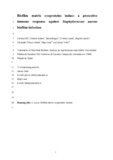Mostrar el registro sencillo del ítem
Biofilm matrix exoproteins induce a protective immune response against Staphylococcus aureus biofilm infection
| dc.creator | Gil Puig, Carmen | es_ES |
| dc.creator | Solano Goñi, Cristina | es_ES |
| dc.creator | Burgui Erice, Saioa | es_ES |
| dc.creator | Latasa Osta, Cristina | es_ES |
| dc.creator | García Martínez, Begoña | es_ES |
| dc.creator | Toledo Arana, Alejandro | es_ES |
| dc.creator | Lasa Uzcudun, Íñigo | es_ES |
| dc.creator | Valle Turrillas, Jaione | es_ES |
| dc.date.accessioned | 2016-11-04T15:15:58Z | |
| dc.date.available | 2016-11-04T15:15:58Z | |
| dc.date.issued | 2014 | |
| dc.identifier.issn | 0019-9567 (Print) | |
| dc.identifier.issn | 1098-5522 (Electronic) | |
| dc.identifier.uri | https://hdl.handle.net/2454/22574 | |
| dc.description | Incluye dos ficheros de datos | es_ES |
| dc.description.abstract | The Staphylococcus aureus biofilm mode of growth is associated with several chronic infections that are very difficult to treat due to the recalcitrant nature of biofilms to clearance by antimicrobials. Accordingly, there is an increasing interest in preventing the formation of S. aureus biofilms and developing efficient antibiofilm vaccines. Given the fact that during a biofilm-associated infection, the first primary interface between the host and the bacteria is the self-produced extracellular matrix, in this study we analyzed the potential of extracellular proteins found in the biofilm matrix to induce a protective immune response against S. aureus infections. By using proteomic approaches, we characterized the exoproteomes of exopolysaccharide-based and proteinbased biofilm matrices produced by two clinical S. aureus strains. Remarkably, results showed that independently of the nature of the biofilm matrix, a common core of secreted proteins is contained in both types of exoproteomes. Intradermal administration of an exoproteome extract of an exopolysaccharide-dependent biofilm induced a humoral immune response and elicited the production of interleukin 10 (IL-10) and IL-17 in mice. Antibodies against such an extract promoted opsonophagocytosis and killing of S. aureus. Immunization with the biofilm matrix exoproteome significantly reduced the number of bacterial cells inside a biofilm and on the surrounding tissue, using an in vivo model of mesh-associated biofilm infection. Furthermore, immunized mice also showed limited organ colonization by bacteria released from the matrix at the dispersive stage of the biofilm cycle. Altogether, these data illustrate the potential of biofilm matrix exoproteins as a promising candidate multivalent vaccine against S. aureus biofilm-associated infections. | en |
| dc.description.sponsorship | J. Valle was supported by Spanish Ministry of Science and Innovation “Ramón y Cajal” contract. This research was supported by grants ERANET Pathogenomic (GEN2006-27792-C2-1-E/PAT), BIO2011-30503- C02-02, and AGL2011-23954 from the Spanish Ministry of Economy and Competitivity and IIQ14066.RI1 from Innovation Department of the Government of Navarra. | en |
| dc.format.mimetype | application/pdf | en |
| dc.format.mimetype | application/zip | en |
| dc.language.iso | eng | en |
| dc.publisher | American Society for Microbiology | en |
| dc.relation.ispartof | Infection and Immunity, March 2014, vol. 82, no. 3, 1017-1029 | en |
| dc.rights | © 2014, American Society for Microbiology. All Rights Reserved. | en |
| dc.rights | © del material complementario: los autores | es_ES |
| dc.subject | Staphylococcus aureus | en |
| dc.subject | Biofilms | en |
| dc.subject | Extracellular proteins | en |
| dc.subject | Immune response | en |
| dc.title | Biofilm matrix exoproteins induce a protective immune response against Staphylococcus aureus biofilm infection | en |
| dc.type | Artículo / Artikulua | es |
| dc.type | info:eu-repo/semantics/article | en |
| dc.contributor.department | IdAB. Instituto de Agrobiotecnología / Agrobioteknologiako Institutua | es |
| dc.rights.accessRights | Acceso abierto / Sarbide irekia | es |
| dc.rights.accessRights | info:eu-repo/semantics/openAccess | en |
| dc.identifier.doi | 10.1128/IAI.01419-13 | |
| dc.relation.projectID | info:eu-repo/grantAgreement/MICINN//BIO2011-30503-C02-02/ES/ | en |
| dc.relation.projectID | info:eu-repo/grantAgreement/ES/6PN/AGL2011-23954 | en |
| dc.relation.publisherversion | https://dx.doi.org/10.1128/IAI.01419-13 | |
| dc.type.version | Versión aceptada / Onetsi den bertsioa | es |
| dc.type.version | info:eu-repo/semantics/acceptedVersion | en |
| dc.contributor.funder | Gobierno de Navarra / Nafarroako Gobernua: IIQ14066.RI1 |


